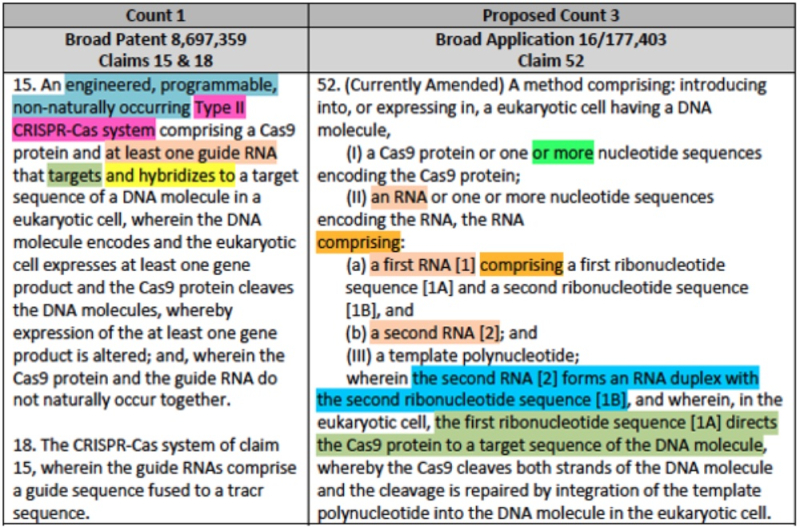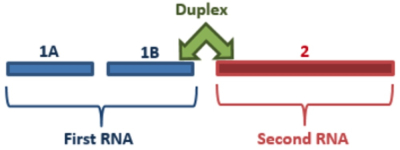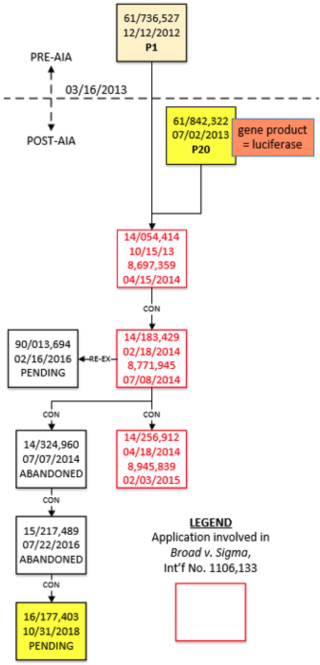On December 3rd, Junior Party the Broad Institute, Harvard University, and MIT (collectively, Broad) filed its Substantive Preliminary Motion No. 1 in Interference No. 106,133 (which names Sigma-Aldrich as Senior Party), asking the Patent Trial and Appeal Board to substitute the interference Count, pursuant to the provisions of 37 C.F.R. §§ 41.121(a)(1)(i) and 41.208(a)(2). On March 16th Senior Party Sigma-Aldrich filed its Opposition to Broad's Motion.
As a reminder, Broad's Proposed Substitute Count takes the "McKelvey" format (comprising in the alternative a claim from one of each Party's applications in interference); the proposed change is in the portion of the Count reciting Broad's claims:
Proposed Count No. 3 (numbered presumably for consistency with other pending CRISPR-related interferences):
Sigma-Aldrich Application No. 15/456,204 (as declared)
or
Claim 2 of Broad Application No. 16/177,403:
52. A method comprising: introducing into, or expressing in, a eukaryotic cell having a DNA molecule,
(I) a Cas9 protein or one or more nucleotide sequences encoding the Cas9 protein;
(II) an RNA or one or more nucleotide sequences encoding the RNA, the RNA comprising: (a) a first RNA comprising a first ribonucleotide sequence and a second ribonucleotide sequence, and (b) a second RNA;
and
(III) a template polynucleotide;
wherein, the second RNA forms an RNA duplex with the second ribonucleotide sequence, and
wherein, in the eukaryotic cell, the first ribonucleotide sequence directs the Cas9 protein to a target sequence of the DNA molecule, whereby the Cas9 cleaves both strands of the DNA molecule and the cleavage is repaired by integration of the template polynucleotide into the DNA molecule in the eukaryotic cell.
In proposing this Substitute Count, Broad emphasizes Sigma-Aldrich's contentions during prosecution that its invention comprised "cleave + insertion" CRISPR methods in eukaryotic cells which were patentably distinct from embodiments comprising "cleavage only" followed by non-homologous end joining of the cleaved DNA target. In making this Motion, Broad clearly intends to cabin Broad's claims at risk in the interference to a small subset of its claims.
In support of its Motion, Broad relied heavily on Sigma-Aldrich's arguments taking substantially the same position in Interference No. 106,132 against Junior Party the University of California, Berkeley; the University of Vienna; and Emmanuelle Charpentier (collectively, "CVC") (see "Sigma-Aldrich Files Substantive Preliminary Motion 1 to Change the Count in Interference No. 106,132"), including arguments Sigma-Aldrich has made regarding the propriety of its claims not being part of other interferences having interfering subject matter limited to "cleavage only" eukaryotic CRISPR methods:
Sigma is properly not a party to those pending 'cleavage only' interferences because all of Sigma's involved claims are directed solely to the patentably distinct 'cleavage plus integration' technological advance in the art.
Sigma-Aldrich's Opposition's first argument for the Board to deny Broad's Motion No. 1 is procedural, that Claim 52 of U.S. Application No. 16/177,403 (the '403 application) had not been determined to be allowable when Broad filed its motion. In addition, Sigma-Aldrich contends "Broad's Claim 52 is exceedingly broad for at least eight reasons," as well as being properly subject to the first inventor to file requirements under the Leahy-Smith America Invents Act (and thus ineligible for consideration in an interference). Sigma-Aldrich also contends that" Broad never even asserts, let alone demonstrates, that "cleavage plus altering gene expression" is patentably distinct from "cleavage plus integration by [Homology-Dependent Recombination] HDR" (in a footnote providing a tally that "[o]f Broad's 461 involved patent claims, 340 claims are directed to "cleavage plus altering gene expression" (or an analogous recital), 42 claims are directed to insertion of a "template", and 8 dependent claims are directed to "cleavage plus integration by HDR"). Finally, Sigma-Aldrich asserts that Broad has neglected to "explain how Claim 52 is patentable over Sigma P1." Citing Louis v. Okada, 2011 Pat. App. 21 LEXIS 24048, at *10 (BPAI May 25, 2011), Sigma-Aldrich contends that a party in an interference must show that there is a genuine need to change the Count and not make a "change for change's sake."
With regard to the procedural deficiencies of Claim 52, Sigma-Aldrich asserts that Claim 52 on the date Broad files its motion had not been determined to be allowable by the Examiner and, indeed, prosecution of the '403 application had been suspended by the Examiner due to the Declaration of the '133 Interference (and is still suspended). As Sigma-Aldrich notes, "[i]nexplicably, the Examiner indicated Claim 52 was allowable 9 days before Time Period 3 in the interference (the deadline for filing Oppositions to each party's Preliminary Motions, as well as arising after cross-examination of each party's expert witnesses). This "after-the-fact (and procedurally improper)" occurrence doesn't provide Broad with justification to file its Motion prior to the Examiner's allowance of Claim 52, Sigma-Aldrich asserts. And moreover, Sigma-Aldrich contends that Broad's filing of their motion is contrary to the Board's mandates when it granted leave on September 20, 2022 for the parties to file their preliminary motions, specifically:
Broad's proposed Count 3 also includes Sigma application 15/456,204 claim 31, as in Count 1, but replaces Broad patent 8,697,359, claim 15 with Broad application 16/177,403 claim 52, which has not yet been determined to be allowable. (See Broad List, Paper 21, 5:7–6:12.)
Authorization for this motion is GRANTED to the extent that Broad may present arguments to substitute current Count 1 with proposed Count 3 wherein the Broad portion of the count reflects a patented or allowable claim. The motion shall be entitled "BROAD MOTION 1."
Sigma-Aldrich sets out a timeline for the Board's consideration, and in particular Broad's assertion in the motion that Claim 52 had been allowed (which seems at a minimum premature):

As set forth in its Opposition, Sigma-Aldrich identifies four substantive changes between the version of Claim 52 contained in Broad's proposed Count No. 3 and Claim 52 as allowed: the amendment "(1) introduces the new limitation of cleaving "both strands" of the DNA; (2) converts the active language limitation that "the template polynucleotide repairs" the cleavage, to the passive language limitation that the cleavage "is repaired by integration of the polynucleotide into the DNA molecule"; (3) introduces the term "integration" into the claim for the first time; and (4) removes the limitation that the cleavage repair is "by homology directed repair." Moreover, Sigma-Aldrich contends that the Examiner did not in fact indicate Claim 52 was allowable, either upon filing the amendment or in the "miscellaneous communication – no action count" communication issued thereafter, characterizing Broad's assertions to the contrary "misleading." Sigma-Aldrich reproduces portions of the U.S. Patent and Trademark Office's Patent Application Information Retrieval (PAIR) website to illustrate its argument in this regard, supported by copies of Office Actions containing express statements such as "The request for reconsideration has been considered but does NOT place the application in condition for allowance."
Sigma-Aldrich cites this evidence in support of its argument that Claim 52 was not in condition for allowance before the deadline date of Time Period 1, when Preliminary Motions were due. This evidence is also an indication that the Examiner's actions "indicating" Claim 52 was allowable are procedurally irregular, according to Sigma-Aldrich because, inter alia, they "change[d] the fundamental operative facts for a contested Motion pending before the Board," which "is inconsistent with at least the spirit of the USPTO's rules." "[C]ountenancing such ex parte maneuvering to alter key facts that are in an active inter partes dispute," Sigma-Aldrich contends, threatens to "undermine the Board's sole jurisdiction over the disputed subject matter, and would encourage future parties to similarly leverage ongoing ex parte prosecution to gain a possible strategic advantage in a co-pending interference." These allegations, of course, raise issues going far beyond this Motion and this Interference and implicate the Board's institutional legitimacy. In this interference Sigma-Aldrich contends that these activities are prejudicial.
The Opposition then asserts that on the merits Broad has failed to satisfy its burden that changing the Count is necessary in this interference, specifically with regard to lacking the assertion that such a change will accommodate a party's "best proofs." In addition, Sigma-Aldrich contends that the "best proofs" of its invention Broad asserts do not require a donor template, even though proposed Count 3 expressly requires a donor template, citing Broad's affirmative assertions in its Motion No. 1. Sigma-Aldrich also characterizes Broad's arguments to use the term "non-template claims" to "fabricate" a self-serving argument Sigma-Aldrich says it has not made. Sigma-Aldrich further argues that Broad has mischaracterized its arguments regarding what is patentably distinct, and also has failed to argue that Count 1 recites two patentably distinct inventions. Continuing its theme of Broad's mischaracterizations, Sigma-Aldrich states that "Broad alters the quotes of Sigma's arguments in that parallel interference [No. 106,132] in a misleading attempt to redraft CVC's claim limitation into two separate components: "such as 'cleaving or editing' or 'modulating transcription,'" whereas Sigma-Aldrich contends that it made clear in that interference that "CVC's claims permit proofs of invention directed to cleavage alone" (emphasis in brief). (Sigma-Aldrich makes a similar argument with regard to there being any patentable distinction between Sigma's claims to "cleavage + integration by HDR" and Broad's claims to "cleavage + altering gene expression.") Sigma-Aldrich reminds the Board that its position, made in its List of Proposed Motions, was that Count 1 encompassed CRISPR-mediated cleavage in a eukaryotic cell either to integrate a heterologous DNA sequence or alter expression of the targeted gene sequence (Sigma-Aldrich attesting to have taken the same position before the Board in the '132 Interference; indeed, Sigma-Aldrich expends several pages of its Opposition outlining specifically how its positions taken in this interference are "entirely consistent" with its positions taken in the '131 Interference). And, as Sigma-Aldrich notes, "[e]ven assuming arguendo that Sigma had raised a distinction between "cleavage plus integration" claims and so-called "Non-Template Claims" (which as discussed above is not true), Broad itself—as the movant—does not make any such contention in its motion." Broad has been content, according to Sigma-Aldrich, with "rel[ying] on Sigma's supposed arguments, while purposely taking no position itself on that (completely self-fabricated) issue" (emphasis in brief), citing almost two dozen instances of this alleged rhetorical conduct in Broad's Motion. It is but a short hop in Sigma-Aldrich's argument to its conclusion that Broad has accordingly not satisfied its burden that there is a good reason to change the Count in this interference. Sigma-Aldrich further argues that Broad has not shown that its "best proofs" include both sgRNA and dgRNA species.
Sigma-Aldrich also sets forth a claim chart, comparing Claim 15 and 18 of its U.S. Patent No. 8,697,359 (which form the basis for Broad's contribution to Count 1 as declared in this interference with Broad's Claim 52 of U.S. Application No. 16/177,403:

Sigma-Aldrich argues that this comparison shows that "Broad's unallowed Claim 52 is excessively broad and thus grossly inadequate to reasonably conform to either of the parties' inventions, not the least of which is that Claim 52 is not even limited to a CRISPR-Cas9 system."
These arguments include that:
• "Broad Claim 52 is not limited to a "standard" CRISPR-Cas9 system, illustrated by this claim comparison:
• "Broad's Claim 52 encompasses NHEJ end ligation, which is fundamentally different from homology-directed repair," illustrated by this claim comparison:

• "Broad Claim 52 encompasses a system with no tracr-RNA/Activator RNA that interacts with the Cas9 protein," end ligation, which is fundamentally different from homology-directed repair," illustrated by this claim comparison:

• "Broad Claim 52 encompasses a crRNA/Targeter RNA that performs all of the guiding functions of the guide RNA (emphasis in brief)," illustrated by this graphic:

• "Broad Claim 52 does not require that the guide RZNA hybridize to/bind with the target sequence," illustrated by this claim comparison:

• "Broad Claim 52 encompasses a split-Cas9 System, which Is beyond the scope of this interference and Broad's disclosed proofs of invention," illustrated by this graphic from Broad's Application 61/915,267:

• "Broad Claim 52 encompasses a guide RNA genus, but Broad's Disclosed proofs of invention are limited to a sgRNA species," and

• "Broad Claim 52 encompasses a wild-type Cas9 protein that would not be capable of entering a eukaryotic cell."
Sigma-Aldrich illustrates its AIA-related argument, that Broad's '403 application is not entitled to pre-AIA treatment with this graphic, showing the disjuncture between pre- and putatively post-AIA priority dates:

The basis for Sigma-Aldrich's assertions is that these applications claim embodiments comprising luciferase, which Sigma-Aldrich contends is not disclosed in any pre-AIA priority documents and thus breaks the benefit chain to pre-AIA treatment, a position Sigma-Aldrich argues it has taken since filing an Appendix to its List of Proposed Motions, and supported by this table:

Sigma-Aldrich's final two arguments in its Opposition are that, to the extent that claim correspondence is at issue between the parties it has addressed those arguments more fully in its Opposition to Broad's Preliminary Motion No. 3, and that the final deficiency in Broad's arguments in support of its motion to change the Count is that its motion fails to assert, much less establish, that its proposed Count 3 is patentable to Broad over Sigma's Provisional Application No. 61/734,256.